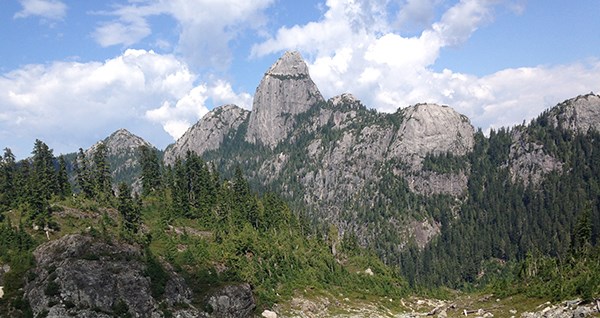Climbing treads the line between life and death, sport, self-exploration and lifestyle.
After reading Leigh McClurg’s June 4 Squamish Chief story about failure in the mountains, “Turning back: It’s not failure,” I reflected on a recent time when I turned around before the top, failing to reach the summit because of dwindling time on the clock. My bitter-tasting failure soon mellowed into the sweet wine of good judgment and enriching experience.
It was 10:30 a.m. on the day when I came up with the plan to scramble up Mt. Habrich via the West Ridge. In hindsight, this was a bit late, as start times go.
I flitted around the house frenetically, snatching the gear I thought I needed. Small pack, wind shell, one litre of water, food, shorts, shirt, socks and extra socks and trail runners were the basics to explore how the gondola has changed the experience of summiting one of the coast’s sub-alpine granite peaks.
Stepping out of the gondola car, my shuffle already playing, I jogged off down the dirt road towards the Shannon Creek Valley. You might wonder why I didn’t go towards Al’s Habrich Ridge trail if I was heading for Mt. Habrich. This trail is a more scenic route created by the gondola trail builders, but with more distance. I chose the old tried and true climber’s route that begins down the road to Sky Pilot.
Once at the old campfire ring, I headed hard left up the climber’s approach trail to Mt. Habrich. This trail is flagged and well worn but so steep it feels like the dirt version of low-angle rock climbing. Up through the forest I went, marvelling at the angle the trees grow at compared to the ground. Spat out and wrung out on the saddle west of Mt. Habrich, the mountain loomed above, impossibly high with an unreachable summit.
Then came the technical crux of the day, delicate route-finding through the tiered ledge systems of Habrich’s west ridge. Here I had my first pang of worry. I had no rock shoes and was not intent on alpine soloing, and this route might be a bit much for trail runners.
It had already taken enough time that the simple math began rolling around in my head. How long to here? Approximately how long up? I mentally added time for route finding errors, then reversing route back down. I was pretty sure I was going to be late if I pushed on for the summit at all costs. But…
Maybe, I thought, I should just sniff around and see what the way is like, giving myself a cut-off time before reversing my path and descending the approach back to the gondola? Maybe it’s simpler and easier than I think?
I set off.
I tunnelled through evergreens and bushes and came to the first in a series of fixed and knotted ropes. Hmmm, to trust or not to trust, how are the shape of the ropes, their age, what could they be anchored to? Timidly I tested it and then committed to the first rope. After four of these, I hit an impasse where the route became less clear and I had hit my turnaround time.
Riding down in the gondola car, I reflected on my failed attempt to summit Mt. Habrich. I should have run faster, ascended the climber’s trail more quickly, nailed the route finding first try. Or should I have? I’d never been up this trail before and had not chosen the best day to go. The conditions had been perfect and surprisingly beautiful for a near-vertical stairway of moss, logs, rocks and dirt.
The route finding crux had been fairly straightforward, the fixed ropes in good condition and the features of the west ridge looked impressive and interesting.
It made me want to go back, just to grind up to that saddle and then find the path of least resistance to the top.
What can you ask for but a great day and then even more interest in heading back again with more time?
Ultimately, the decision making that had kept me safe, moving at a good pace, enjoying the place and home on time to jump back into normal life all contribute to an empowering feeling that you can exist within, navigate and enjoy those moments of being out there pushing yourself and exploring the mountains. That feeling of control – moving confidently and self sufficiently through terrain and weather as a small and vulnerable animal – goes well beyond simply tagging another summit. It speaks to why mountains have always been regarded as such great teachers.




